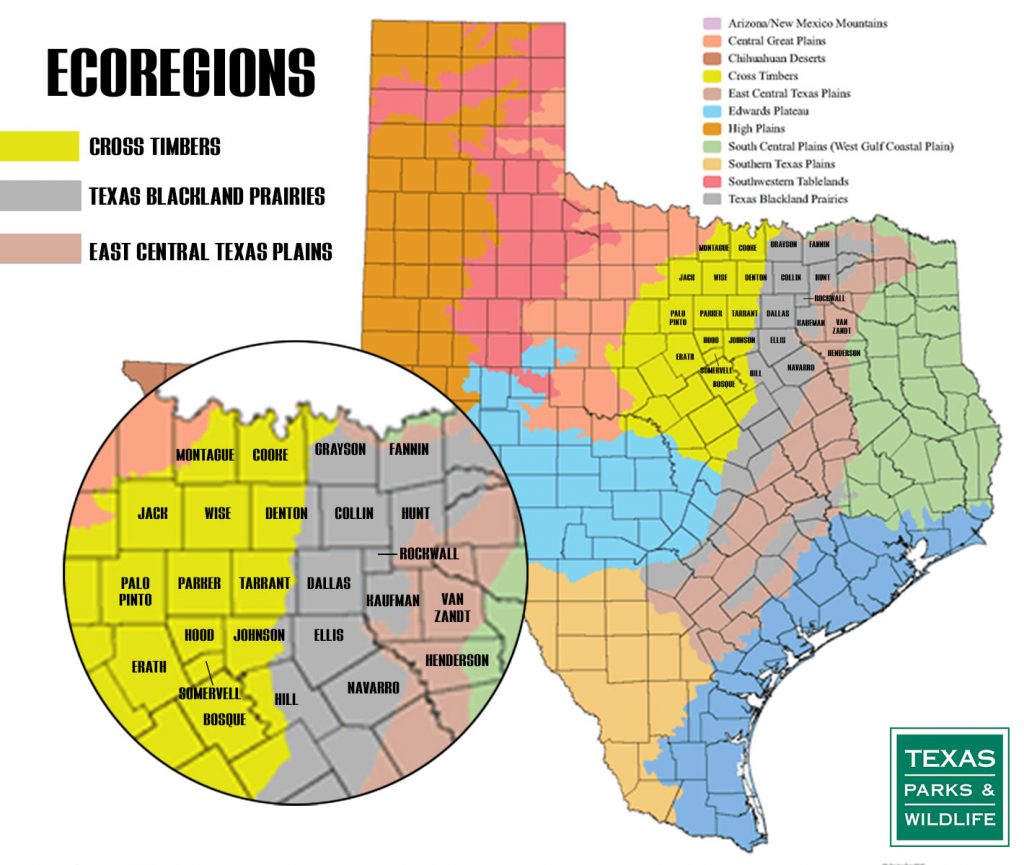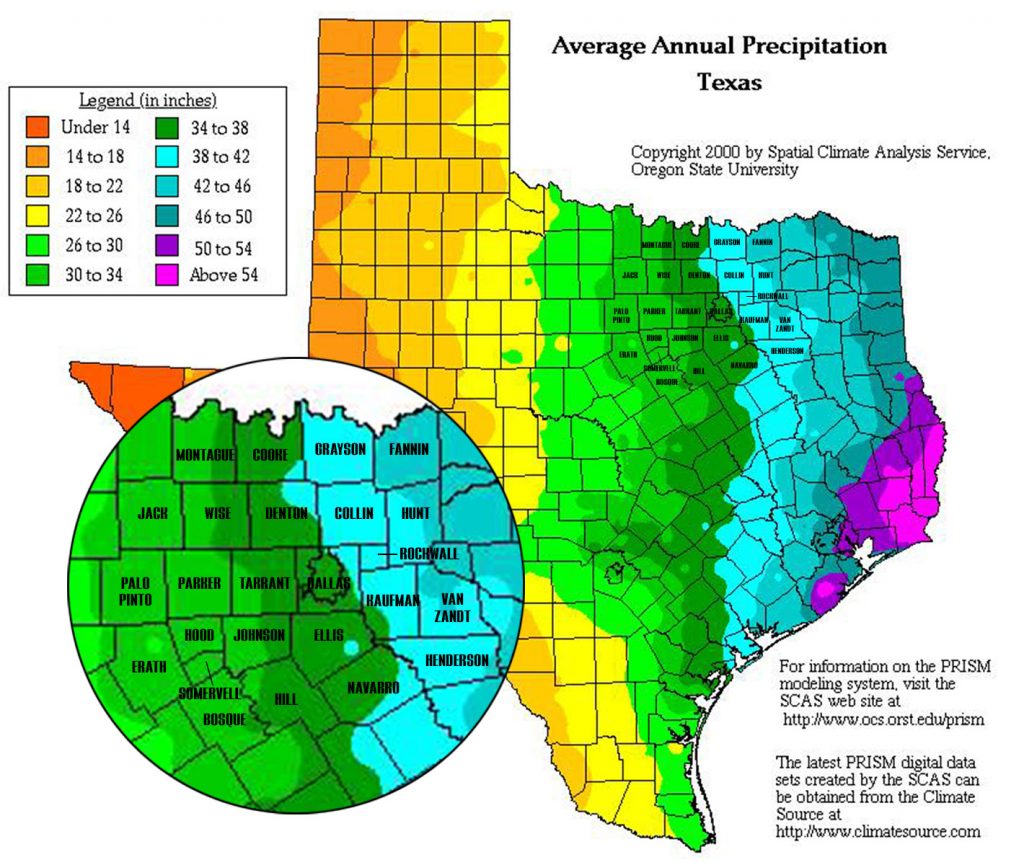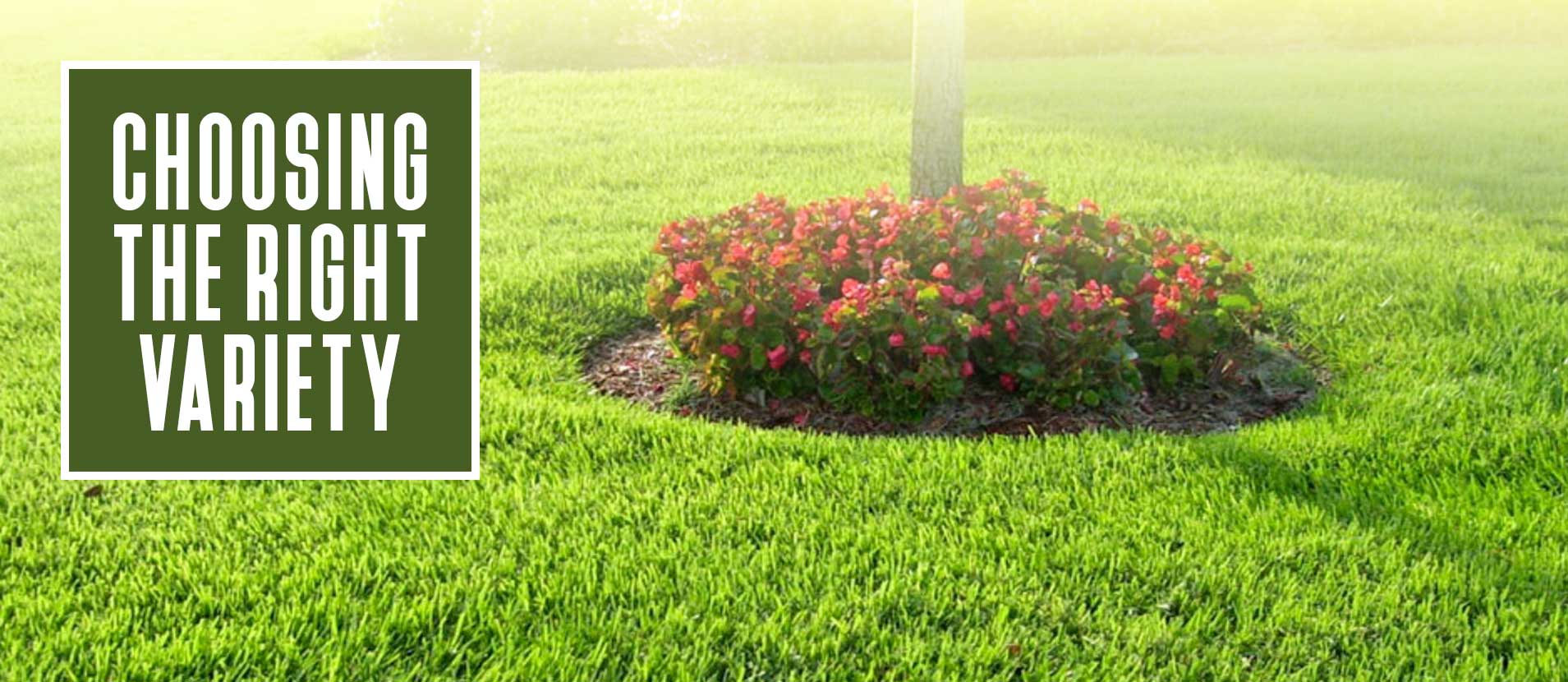What grass variety is best for the North Texas DFW area? It seems like a simple question on the surface, but the answer is much more complex and elusive. What you should be asking is what variety of grass is best suited for you? To answer that, you need to not only take into account the climate and soil conditions for your area, but the look you want and the level of care you plan to put into maintaining your turf grass.
Extreme summer temperatures, plus winters that get cold enough for several freezes a year mean choosing between warm season or cool season grasses. Warm season grasses are the best option for DFW and the varieties that Tri-Tex Grass offers will stand up to the summer sun and to our periodic cold spells. They will provide a green carpet for most of the year, but there is no grass available that will be green year round in our area. All our varieties are suitable to a wide range of soil types and to varying levels of drought tolerance, but some perform better in certain conditions than others.
Here are some points to ponder before making your turf grass choice:
• Amount of rainfall you receive and supplemental water usage
• Soil conditions
• How much sun your yard gets
• Drainage issues
• Usage–traffic tolerance
• Appearance–color and texture
• Maintenance–mowing and feeding
CONSIDERATIONS
Climate of DFW
The Dallas, Fort Worth and surrounding areas fall into three distinct ecoregions according to Texas Parks and Wildlife and the average yearly rainfall totals can vary by as much as twelve inches from one end to the other (see map). Driving from East Dallas through Arlington, Fort Worth and to our location in Granbury, the change in native vegetation is pretty dramatic and directly reflects the reduction in rainfall as you travel westward. The bulk of Dallas, Tarrant and the counties between them fall within an average yearly rainfall range of 34 to 38 inches. Eastern areas range from 38 to 42 inches while western rainfall totals average 30 to 34 inches a year. We’ve had recent experiences of both record rainfalls and extreme drought, so installing a grass that can stand up to extremes, especially drought, could be a big factor in your turf grass decision.
Ecoregions
The ecoregions roughly correspond to rainfall totals, but view the provided maps for more details. East Central Texas Plains–Primarily east of Dallas County. Typically the native soil is light-colored, acidic sandy loam. Texas Blackland Prairie–All of Dallas County through a small part of Tarrant county. The name comes directly from the fertile black soil that characterizes the area. Often called “black gumbo”, the soil is uniformly dark-colored alkaline clay with some gray acidic sandy loam. Cross Timbers–Tarrant County and western. Soils are primarily sandy to loam to caliche. Caliche is a whitish-gray or cream-colored soil layer that has been cemented by carbonates of calcium and magnesium. These carbonates bind with soil particles like sand, clay, or silt to become hardened deposits.
If you are starting with a clean slate, you can choose a grass that you know pairs well with your native soil or with the type of soil that you are planning to bring in. If you are considering replacing existing turf or using your native soil, you might consider purchasing a soil testing kit to determine whether your soil is acidic, neutral or alkaline. It will also help you determine which elements are missing from your soil and how much to add to keep your chosen grass performing at its peak level. The depth of your soil may also be important for certain grass varieties.
Sun Exposure
The amount of sun or shade that your lawn receives will have a large impact on your available turf grass choices. Mature trees, solid fences and the proximity of your neighbor’s homes could all have a dramatic impact on the amount of light certain areas of your yard receives. For example, Tifway 419 Bermuda needs a minimum of 10 to 12 hours of sunlight daily. Whereas St Augustine can subsist on 4 hours of direct sunlight, plus additional filtered light. Be realistic in your expectations. Some grass varieties will creep into shady areas, but no grass is going to perform well in deep shade. You can raise your tree canopy and prune yearly to help get more sunlight in some of these areas. The alternative is to forego grass in deep shade and substitute something like mondo grass, Asian jasmine or simple mulch in its place.


Water and Drainage
Ninety percent of grass problems are the result of too much or too little water, so choosing the right grass variety for your expected water usage is important. In addition, statistics indicate that anywhere from 40% to 70% of a homeowners water usage is attributed to watering the lawn. That’s considerable. Your turf grass choice will have a big impact on that number. One newer variety of Bermuda called TifTuf reports a 38% lower water usage compared to other Bermudas. Zoysia varieties also provide good drought tolerance, but may not be as green during times of drought, so you will need to weigh your appearance expectations against your water usage. In recent years, many cities have imposed watering restrictions during the summer months. You’ll need to choose a grass variety with a higher drought tolerance if this is an issue for you to avoid putting too much stress on a grass not suited for extended drought conditions. Over the long run, repeated stress will cause damage to roots that translates to visible damage. Soil also needs to be able to dry out between waterings. Over watering is as damaging as under watering and can lead to green mold if proper drainage isn’t available due to compacted soil or uneven leveling. Our seasonal thunderstorms can result in this as well. Grass varieties like St Augustine or Bermuda won’t grow under those conditions.
Appearance and Usage
There is no one-size fits all. You may have a very different idea of the perfect lawn compared to your neighbor. This is where your personal wants and needs come into play. Is your lawn purely for aesthetic beauty or will you have kids running and playing on it? What about the daily wear and tear of a dog or two? Traffic tolerance and the ability to recover from damage could be very important factors for you. You can even create your own personal putting green using Tif Eagle Bermuda’s very fine-leaf bladed grass. Multiple shades of green from deep to bright to grey are available, plus varying widths of leaf blades, so you can find the texture that feels perfect on your bare feet (if you are barefoot kind of person).
Upkeep
Do you gaze out at the lawn and think, “it can probably go another week before mowing” or are you the type that is just waiting for it to be a decent enough hour to get your mower out and not upset the neighbors? Do you know the optimum pH, phosphorous, potassium and nitrogen levels of your lawn and adhere to a strict schedule or should your lawn consider itself lucky to get one feeding a year? These are questions you need to ask yourself while remembering that good intentions often fall to the wayside.
WARM SEASON GRASS VARIETIES
Bermuda Hybrids
Tri-Tex Grass offers four distinct Bermuda hybrid varieties each with its own unique qualities. Historically, Bermuda grass has been a full sun only option, but even that has changed with the release of TifTuf Bermuda as hybrid Bermudas continue to be a focus of scientific improvement. All the Bermudas are vigorous growers and have both excellent traffic tolerance and recovery making them great for kids and pets. Like Zoysia, up front costs are higher, but you’ll save money in the long haul with reduced water bills.
TifTuf Bermuda
This new Bermuda hybrid shows a significant improvement in drought tolerance and reduced water usage over any Bermuda. TifTuf used 38% less water than its well-known cousin, Tifway 419, thereby potentially paying for itself in as little as 1.7 years. Unlike Zoysia, it stays green under drought stress. It also stands up to heavy traffic and recovers quickly from damage. In addition to its superior drought tolerance, what sets TifTuf apart from the other Bermudas is its shade tolerance. TifTuf has been shown to do well with as little as 25% of the light it would experience in full sun making it a viable choice for yards that have both full sun and dappled light. It can also live beneath mature trees whose roots normally leave the surrounding area dry. TifTuf is a deep green color with a fine leaf blade. A mow height of 1/2 to 2 inches is best.
For additional detail on TifTuf, please read the blog post “TifTuf™ Bermuda. Does it Live Up to the Hype?”
Tifway 419 Bermuda
With a nearly 60-year history behind it, Tifway 419 Bermuda is a dependable turf grass. It provides a beautiful, deep grayish green carpet made of medium fine leaf blades. As the most popular hybrid Bermuda turf in the South for golf and sports field use, it’s proven it can take a beating and recover rapidly from the abuse. When fully established, Tifway 419 has excellent drought and heat tolerance. It does prefer full sun and has little shade tolerance. You can also expect it to stay green longer than other Bermudas under stress (only TifTuf beats it). A mow height of 1/2 to 2 inches is recommended. For peak performance, you do need to fertilize Tifway 419 and it’s helpful to provide some weed control.
For additional information on Tifway 419, please read the blog post “Tifway 419 Bermuda: An Established Winner.”
Tif Eagle Bermuda
Golfers will be familiar with this hybrid Bermuda even if you don’t recognize the name. Tif Eagle is the grass of choice for courses in the South. Very fine blades stand erect and can be cut to a height of as little as 1/8 inch. Looking to create your own personal putting green at home? Tif Eagle is the perfect choice.
Midiron Bermuda
The deep root system of the Midiron makes it the most cold tolerant of the hybrid Bermudas we offer. That deep root system also makes it a great choice for sloped areas where erosion control may be needed. Its beautiful blue-green color is coupled with a medium coarse leaf that feels great under your bare feet. Recommended mow height is 1 to 2-1/2 inches, but can be as low as a 1/2 inch. Like most Bermudas, its shade tolerance is poor. Midiron is actually the most popular variety used in Arizona where drought tolerance is also a necessity. It’s resilient under heavy traffic and quick to recover and has low maintenance requirements. It does well in sand, loam and clay soils.
Raleigh Saint Augustine
When you close your eyes and picture a perfect, lush, carpet-like lawn, Saint Augustine is likely what you have in mind. It’s been the go-to grass for Texas lawns for decades for good reason. It’s considered the easiest to maintain, so it’s great for a new homeowner tackling their first lawn. Raleigh is presently the highest ranking cold tolerant, SAD (St. Augustine Decline disease) free St. Augustine grass grown commercially available in Texas. It’s recommended to be mown to 1 to 2 inches but can be maintained as high as 3 inches. It’s dense, not picky about soil and does well in full sun or half a day shade making it a good choice for lawns with dappled light from mature trees. The color is a medium green with a medium to coarse texture. Saint Augustine recovers quickly from damage. To keep watering frequency down, it does prefer at least 6 inches or more of soil depth to create a deep root system. Saint Augustine is the most affordable grass type that does well in the DFW area, but you should balance that with its higher water requirements.
Zoysia Grass
Originally from Asia, Zoysia varieties handle sun, drought and dappled shade well requiring as little as 3 hours of filtered light daily. They are also highly resistant to lawn diseases. Zoysias require half the water of St. Augustine, but the grass itself can cost 50 to 100 percent more. Those up front costs may well save you money in the long haul with reduced water bills. Zoysias are slower growing and really should be planted as sod or it could take a full year for a lawn to fill in, but they are still considered to have good recovery from injury. Zoysia protects itself during dry spells by closing its leaves thereby reducing their surface area to the heat. This can give your lawn a yellow to brown appearance, but they unfurl back to green rapidly with rain or supplemental watering. They aren’t picky about soil type and are considered to have low maintenance requirements. Tri-Tex Grass offers two Zoysia varieties. Zoysia JaMur is the most drought tolerant of commercially produced Zoysias. It has a blue-green color with a medium to coarse texture and should be kept mowed to between 2 and 3 inches. Any lower and weeds could gain a foothold. Zoysia Zeon is the most shade tolerant of ALL known commercially produced warm season turf grass. Zeon was even chosen for landscaping at the Cowboy’s AT&T Stadium in Arlington, Texas. It has a deep green color and fine blades. It can be cut as short as 1/2 inch to around 2 inches for best performance and it has a very dense root system.
Tri-Tex Grass has called Granbury home since 2004. We provide and install high-quality Bermuda grass, St. Augustine grass, zoysia grasses and buffalo grass from our grass farms in Tioga, Pilot Point, Brazos Point and Bryan, Texas. We serve Dallas, Fort Worth, Granbury and surrounding areas. You are welcome to contact us at 940-686-2700 with any questions.

